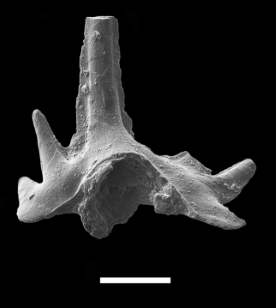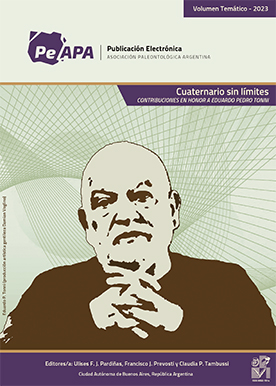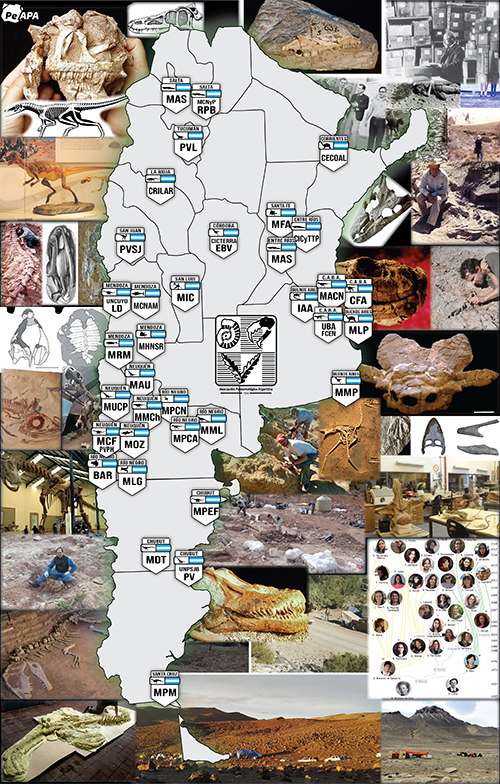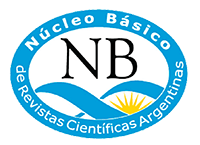BIOESTRATIGRAFÍA DE CONODONTES DEL ORDOVÍCICO MEDIO–SUPERIOR DE LA PRECORDILLERA ORIENTAL, SAN JUAN, ARGENTINA.
DOI:
https://doi.org/10.5710/PEAPA.12.03.2024.480Palabras clave:
Conodontes, Ordovícico, Bioestratigrafía, Precordillera Oriental, ArgentinaResumen
La Formación La Cantera es una unidad silicoclástica de distribución restringida que aflora en el borde oriental de la sierra de Villicum (Precordillera Oriental) en la provincia de San Juan. Su edad ha sido registrada previamente en base a graptolitos. Se coleccionaron varias muestras de conglomerados, areniscas y pelitas de los miembros inferior y medio de la Formación La Cantera, que proporcionaron conodontes y microfósiles como placas de ostracodermos, gastrópodos, briozoos y braquiópodos. La fauna de conodontes recuperada es poco diversa o
simplemente se pueden recuperar como moldes en pelitas. Se compone principalmente de elementos del género Eoplacognathus recuperados de areniscas o elementos del género Pygodus que aparecen en pelitas verdes. Se suman elementos de los géneros Baltoniodus, Pygodus, Periodon
y Erismodus, entre otros, que se recuperaron de areniscas y areniscas conglomerádicas. Las asociaciones de conodontes permiten proponer por primera vez la bioestratigrafía de conodontes del Ordovícico Medio–Superior para la Precordillera Oriental, reconociendo tres zonas y subzonas de conodontes, en orden ascendente: Zona de Lenodus suecicus (Subzona de Pygodus anitae), Zona de Pygodus serra (Subzona de Eoplacognathus robustus) y Zona de Pygodus anserinus (Subzona Superior). Estos nuevos datos bioestratigráficos proporcionan una correlación precisa de esta unidad clásica de la Precordillera Oriental con aquellas unidades de diferentes localidades de la Precordillera Central. Esta correlación permite reconocer varios hiatos en diferentes intervalos de tiempo que revela la inestabilidad de la cuenca durante el Darriwiliano tardío–Sandbiano temprano.
Citas
Aceñolaza, G., Heredia, S., & Carlorosi, J. (2015). Chronostratigraphy and significance of the Cruziana rugosa group (trace fossil) in the Ordovician strata of the South American Central Andean Basin. Comptes Rendus Paleovol, 14, 85‒93.
Agematsu, S., Sashida, K., Salyapongse, S., & Sardsud, A. (2007). Ordovician conodonts from the Satun area, Southern Peninsular Thailand. Journal of Paleontology, 8, 19‒37.
Albanesi, G. L., Benedetto, J. L., & Gagnier, P. Y. (1995). Sacabambaspis janvieri (Vertebrata) y Conodontes del Llandeiliano temprano en la Formación La Cantera, Precordillera de San Juan, Argentina. Boletín de la Academia Nacional de Ciencias, 60, 519‒543.
Albanesi, G. L. & Ortega, G. (2002). Advances on Conodont‒Graptolite Biostratigraphy of the Ordovician System of Argentina. In: Aceñolaza, F.G. (Ed.). Aspects of the Ordovician System in Argentina. Serie Correlación Geológica, 16, 143‒166.
Albanesi, G. L. & Ortega, G. (2016). Conodont and Graptolite biostratigraphy of the Ordovician System of Argentina. In: Montenari, M. (Ed.), Stratigraphy & Timescales, 1, 61–121.
An, T. X. & Zheng, Z. C. (1990). The Conodonts of the Marginal Areas around the Ordos Basin. Science Press.
Armstrong, H. A. & Owen, A. W. (2002). Euconodont diversity changes in a cooling and closing Iapetus Ocean. In J. A. Crane & A. W. Owen (Eds.), Palaeobiogeography and Biodiversity Change: The Ordovician and Mesozoic‒Cenozoic Radiations. Geological Society of London, Special Publications, 194, 85‒98.
Astini, R. A. (2003). The Ordovician Proto-Andean basins. In J. L. Benedetto (Ed.), Ordovician fossils of Argentina (pp. 1‒74). Secretaría de Ciencia y Tecnología, Universidad Nacional de Córdoba.
Baldis, B., Beresi, M., Bordonaro, O., & Vaca, A. (1982). Síntesis evolutiva de la Precordillera Argentina. Actas del 5° Congreso Latinoamericano de Geología (pp. 399‒445). Buenos Aires.
Baldis, B. A. & Blasco, G. (1975). Trilobites ordovícicos de la comarca de Jáchal, Precordillera argentina. 1. Telephinidae. Ameghiniana, 11, 71–87.
Baldis, B. A. & Chebli, G. (1969). Estructura profunda del área central de la Precordillera sanjuanina. Actas de las 4° Jornadas Geológicas Argentinas (vol. 1, pp. 47‒66). Mendoza.
Benedetto, L. (1986). The first typical Hirnantia fauna from South America (San Juan Province, Argentina Precordillera). In P. R. Racherboeuf & D. Emig (Eds.), Les Brachiopodes et actuels. Bioestratigraphie du Paleozoique, 4, 439‒477.
Bergström, S. M. (1962). Conodonts from the Ludibundus Limestone (Middle Ordovician) of the Tvaren area (S. E. Sweden). Arkiv For Mineralogi Och Geologica, 3, 1‒61.
Bergström, S. M. (1971). Conodont Biostratigraphy of the Middle and Upper Ordovician of Europe and eastern North America. In W. C. Sweet & S. M. Bergström (Eds.), Symposium on Conodont biostratigraphy. Geological Society of America Memory, 127, 83‒157.
Bergström, S. M. (1978). Middle and Upper Ordovician conodont and graptolite biostratigraphy of the Marathon, Texas graptolite zone reference standard. Palaeontology, 21(4), 723‒758.
Bergström, S. M. (1983). Biogeography, evolutionary relationships, and biostratigraphical significance of Ordovician platform conodonts. Fossils and Strata, 15, 35‒58.
Bergström, S. M. (2007). The Ordovician conodont biostratigraphy in the Siljan region, south-central Sweden: a brief review of an international reference standard. Sveriges Geologiska Undersokning Rapporter Och Meddelanden, 128, 26‒41.
Bergström, S. M. & Ferretti A. (2017). Conodonts in Ordovician biostratigraphy. Lethaia, 50(3), 424–439.
Bergström, S. M., Riva, J., & Kay, M. (1974). Significance of conodonts, graptolites, and shelly faunas from the Ordovician of Western and North Central Newfoundland. Canadian Journal of Earth Sciences, 11, 1625‒1660.
Davies, N., Sansom, I., Albanesi, G. L., & Céspedes, R. (2007). Ichnology, palaeoecology and taphonomy of a Gondwanan early vertebrate habitat: Insights from the Ordovician Anzaldo Formation, Bolivia. Palaeogeography, Palaeoclimatology, Palaeoecology, 249, 18‒35.
Dzik, J. (1994). Conodonts of the Mójcza Limestone. In J. Dzik, E. Olempska & A. Pisera (Eds.), Ordovician carbonate platform ecosystem of the Holy Cross Mountains. Palaeontologia Polonica, 53, 43‒128.
Egenhoff, S., Webber, B., Lehnert O., & Maletz, J. (2007). Biostratigraphic precision of the Cruziana rugosa group: a study from the Ordovician succession of Southern and Central Bolivia. Geological Magazine, 144, 289‒303.
Fåheæus, L. E. (1966). Lower Viruan (Middle Ordovician) conodonts from the Güllhögen quarry, southern central Sweden. Sveringes Geologiska Undersökning, 60(5), 1‒40.
Feltes, N., Serra, F., Ortega, G., & Albanesi G. L. (2019). Graptolite and conodont faunas of Upper Ordovician (Sandbian) successions of the Argentine Precordillera: Biostratigraphic implications. Geological Journal, 54, 2301‒2322.
Furque, G. & Cuerda, A. J. (1979). Precordillera de La Rioja, San Juan y Mendoza. In J. C. M. Turner (Ed.), Geología Regional Argentina (pp. 455–522). Academia Nacional de Ciencias.
Gagnier, P. Y., Bliek, A., Emig, C., Sempere, T., Vachard, D., & Vanguestaine, M. (1996). New paleontological and geological data on the Ordovician and Silurian of Bolivia. Journal of South American Earth Sciences, 9, 329‒347.
Hadding, A. R. (1913). Undre dicellograptusskiffern I Skåne jamte några därmed ekvivalenta bildningar. [Doctoral thesis, Lunds Universitet].
Hamar, G. (1964). The Middle Ordovician of Oslo Region, Norway. Norsk Geologisk Tidsskrift, 44(2), 243‒292.
Hamar, G. (1966). The Middle Ordovician of the Oslo region, Norway. 22 Preliminary report on conodonts from the Oslo-Asker and Ringerike districts. Conodonts from Lower Middle Ordovician of Ringerike. Norsk Geologisk Tidsskrift, 46(1), 27‒83.
Harris, A. G., Bergström, S. M., Ethington, R. L., & Ross, R. J. (1979). Aspects of Middle and Upper Ordovician conodont biostratigraphy of carbonate facies in Nevada and southeast California and comparison with some Appalachian successions. Brigham Young University Geology Studies, 26, 7‒43.
Heredia, S. (1998). Eoplacognathus robustus (Conodonta) en la Formación Ponón Trehué (Ordovícico Inferior), Sierra Pintada, Provincia de Mendoza, Argentina. Ameghiniana, 35(3), 337‒344.
Heredia, S. (2012). Bioestratigrafía de conodontes del Darriwiliano medio (Ordovícico) de la Formación Las Aguaditas, Precordillera Central. Revista Mexicana de Geología, 29(1), 76‒86.
Heredia, S., Beresi, M., & Mestre, A. (2011). La estratigrafía del Ordovícico Medio del río Las Chacritas, Precordillera Central de San Juan. Serie Correlación Geológica, 27, 18–26.
Heredia, S. & Mestre, A. (2013). Advances in the middle Darriwilian conodont biostratigraphy of the Argentine Precordillera. In G. Albanesi & G. Ortega (Eds.), Conodonts from the Andes. 3Rd International Conodont Symposium. Publicación Especial de la Asociación Paleontológica Argentina, 13, 45‒48.
Heredia, S. & Mestre, A. (2017). Primer registro del conodonte darriwiliano Lenodus antivariabilis An en la Precordillera Central de San Juan, Argentina. In J. L. Benedetto, S. Heredia & G. Aceñolaza (Eds.), Estratigrafía y Paleontología del Paleozoico Inferior de Argentina. Actas del 20° Congreso Geológico Argentino (pp. 38‒42). San Miguel de Tucumán.
Heredia, S. & Mestre, A. (2019). The Middle Ordovician conodonts Eoplacognathus robustus Bergström and E. lindstroemi (Hamar): Taxonomy and apparatus reconstruction. Andean Geology, 46(3), 556‒566.
Heredia, S. & Milana, J. P. (2010). Sandbian (Late Ordovician) conodonts at Quebrada La Pola, Sierra de Villicum, San Juan Precordillera (Argentina). Ameghiniana, 47(4), 515–525.
Heredia, S., Mestre, A., & Kaufmann, C. (2017a). The Darriwilian conodont biostratigraphy from the Argentine Precordillera. In J‒C. Liao & J. I. Valenzuela-Rios (Eds.), Progress on Conodont Investigation. Abstracts of the 4° International Conodont Symposium (pp. 65–69). Valencia.
Heredia, S., Mestre, A., Kaufmann, C., & Soria, T. (2019). Stratigraphic considerations on the Pygodus serra Zone record in the Cuyania Terrane, Argentina. Andean Geology, 46(2), 336‒344.
Heredia, S., Mestre, A., & Soria, T. (2014). Taxonomical review of the conodont genus Eoplacognathus Bergström and its stratigraphical record in the Ordovician of Argentina. In D. Harper & A. Dronov (Eds.), Ordovician biotas of Gondwana: responses to global climatic and eustatic events, and their biogeographic relationships within the Ordovician world. Proceedings of the 4th International Palaeontological Congress. Mendoza, Argentina. Symposium 20.
Heredia, S., Mestre, A., Soria, T., & Kaufmann, C. (2017b). The Ordovician genus Pygodus (conodont) in the Cuyania Terrane, Argentina. Geological Magazine, 154(5), 1105‒1116.
Hints, O., Viira, V., & Nõlvak. J. (2012). Darriwilian (Middle Ordovician) conodont biostratigraphy in NW Estonia. Estonian Journal of Earth Sciences, 61(4), 210–226.
Jing, X. C., Zhou, H. R., Wang, X. L., Yang, Z. H., Fang, Q., Wang, Z. T., & Fan, J. (2020). A review on Ordovician conodont biostratigraphy of the North China Plate and new research advances on its northwestern margin. Earth Science Frontiers, 27, 199–212.
Kaufmann, C. (2019). Estudio de las faunas de graptolitos de la sucesión ordovícica aflorante en la Sierra de Villicum, Precordillera Oriental, San Juan, Argentina. [Doctoral thesis, Facultad de Ciencias Exactas, Físicas y Naturales, Universidad Nacional de San Juan].
Lamont, A. & Lindström, M. (1957). Arenigian and Llandeilian Cherts identified in the Southern Uplands of Scotland by means of Conodonts, etc. Transactions of the Edinburgh Geological Society, 17, 60–70.
Lindström, M. (1955). Conodonts from the lowermost Ordovician strata of south-central Sweden. Geologiska Föreningens i Stockholm Förhandlingar, 76, 517–604.
Lindström, M. (1971). Lower Ordovician conodonts of Europe. Geological Society of America Memoir, 127, 21–61.
Lindström, M. (1977). Genus Eoplacognathus Hamar, 1966. In W. Ziegler (Ed.), Catalogue of Conodonts (volume III, pp. 127–144). Springer Verlag.
Löfgren, A. (1978). Arenigian and Llanvirnian conodonts from Jämtland, northern Sweden. Fossils and Strata, 13, 1‒129.
Männik, P. & Viira, V. (2012). Ordovician conodont diversity in the northern Baltic. Estonian Journal of Earth Sciences, 61, 1–14.
Mestre, A. (2013). Middle Darriwilian conodont biostratigraphy of the Villicum range, Eastern Precordillera, Argentina. In G. Albanesi & G. Ortega (Eds.), Conodonts from the Andes. 3Rd International Conodont Symposium. Publicación Especial de la Asociación Paleontológica Argentina, 13, 69–72.
Mestre, A. (2014). Bioestratigrafía de conodontos del Darriwiliense medio (Ordovícico) en el borde oriental de la Sierra de Villicum (Precordillera Oriental, Argentina). Boletín Geológico y Minero, 125(1), 65–76.
Mestre, A. & Heredia, S. (2020). Lower-middle Darriwilian index conodonts from the Precordillera: New taxonomical approaches. Palaeobiodiversity and Palaeoenviroment, 100(3), 737‒746.
Ortega, G., Albanesi, G., & Frigerio, S. (2007). Graptolite-conodont bioestratigraphy and biofacies of the Middle Ordovician Cerro Viejo succession, San Juan, Precordillera, Argentina. Palaeogeography, Palaeoclimatology, Palaeoecology, 245, 245‒264.
Ortiz, A. & Zambrano, J. (1981). La provincia geológica Precordillera Oriental. Actas 8º Congreso Geológico Argentino (vol. 3, pp. 9–74). San Luis.
Peralta, S. (1986). La graptofauna ordovícica de la Formación La Cantera, Precordillera Oriental de San Juan. Actas 4° Congreso Argentino de Paleontología y Bioestratigrafía (pp. 59‒66). Mendoza.
Peralta, S. (1993). Estratigrafía y consideraciones paleoambientales de los depósitos marino- clásticos eopaleozoicos de la Precordillera Oriental de San Juan. Actas del 12° Congreso Geológico Argentino y 2° Congreso de Exploración de Hidrocarburos (pp. 128–137). Mendoza.
Purnell, M. A., Donoghue, P. C. J., & Aldridge, R. J. (2000). Orientation and Anatomical Notation in Conodonts. Journal of Paleontology, 74, 113‒122.
Rasmussen, J. A. (2001). Conodont biostratigraphy and taxonomy of the Ordovician shelf margin deposits in the Scandinavian Caledonides. Fossils and Strata, 48, 1–180.
Stone, J. (1987). Review of investigative techniques used in the study of conodonts. In R. Austin (Ed.). Conodonts: Investigative Techniques and Applications (pp. 17‒34). Ellis Horwood Limited.
Stouge, S., Bauert, G., Bauert, H., Nolvak, J., & Rasmussen J. A. (2016). Upper Middle to lower Upper Ordovician chitinozoans and conodonts from the Bliudziai-150 core, southern Lithuania. Canadian Journal of Earth Sciences, 53, 781–787.
Tolmacheva, T. Y., Degtyarev, K. E., Ryazantsev, A. V., & Nikitina, O. I. (2009). Conodonts from the upper Ordovician siliceous rocks of Central Kazakhstan. Paleontological Journal, 43, 1498‒1512.
Viira, V. (1974). Ordovician conodonts of east Baltic. Valgus Publishers [in Russian, with English summary].
Wang, Z. H., Zhen, Y. Y., Bergström, S. M., Wu, R. C., Zhang, Y. D., & Ma, X. (2019). A new conodont biozone classification of the Ordovician System in South China. Palaeoworld, 28(1/2), 173–186.
Wang, Z. H., Zhen, Y. Y., Bergström, S. M., Zhang, Y. D., & Wu, R. C. (2018). Ordovician conodont biozonation and biostratigraphy of North China. Australian Palaeontological Memory, 51, 65–79.
Wu, R., Calner, M., & Lehnert, O. (2016). Integrated conodont biostratigraphy and carbon isotope chemostratigraphy in the Lower–Middle Ordovician of southern Sweden reveals a complete record of the MDICE. Geological Magazine, 154, 334–353.
Zhang, J. H. (1998). The Ordovician conodont genus Pygodus. In H. Szaniawski (Ed.), Proceedings of the 6° European Conodont Symposium (ECOS VI). Palaeontologia Polonica, 58, 87‒105.
Zhang, Y. D., Zhan, R. B., Zhen, Y. Y., Wang, Z. H., Yuan, W. W., Fang, X., Ma, X., & Zhang, J. P. (2019). Ordovician integrative stratigraphy and timescale of China. China Earth Sciences, 62, 61–88.
Zhen, Y. Y. (2021). Middle Ordovician conodont biostratigraphy of Australasia. Journal of Earth Science, 32(3), 474–485.
Zhen, Y. Y., Wang, Z. H., Zhang, Y. D., Bergström, S. M., Percival I. G., & Chen J. F. (2011). Middle to Late Ordovician (Darriwilian-Sandbian) conodonts from the Dawangou section, Kalpin area of the Tarim Basin, northwestern China. Records of the Australian Museum, 63(3), 203–266.
Zhen, Y. Y., Zhang, Y. D., & Percival, I. G. (2009). Early Sandbian (Late Ordovician) conodonts from the Yenwashan Formation, western Zhejiang, South China. Alcheringa, 33, 133–161.

Archivos adicionales
Publicado
Número
Sección
Licencia
Derechos de autor 2024 Susana Heredia, Ana Mestre, Mercedes Gallardo, Florencia Moreno, María José Gómez, Guillermo Aceñolaza

Esta obra está bajo una licencia internacional Creative Commons Atribución-SinDerivadas 4.0.

Los/las autores/as conservan los derechos de autor/a y garantizan a la revista el derecho de ser la primera publicación del trabajo licenciado bajo una licencia CC Attribution-NonCommercial 4.0 que permite a otros/as compartir el trabajo con el reconocimiento de la autoría y de la publicación inicial en esta revista.






















